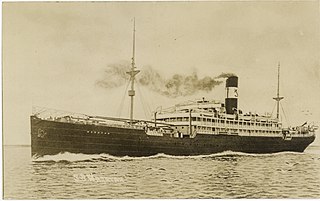
Holland America Line is a British/American-owned cruise line, a subsidiary of Carnival Corporation & plc headquartered in Seattle, Washington, United States.

United States Lines was an American transatlantic shipping company that operated cargo services from 1921 to 1989, and ocean liners until 1969—most famously, SS United States.

SS Uganda was a British steamship that had a varied and notable career. She was built in 1952 as a passenger liner, and successively served as a cruise ship, hospital ship, troop ship and stores ship. She was laid up in 1985 and scrapped in 1992.

SS Waratah was a passenger and cargo steamship built in 1908 for the Blue Anchor Line to operate between Europe and Australia. In July 1909, on only her second voyage, the ship, en route from Durban to Cape Town, disappeared with 211 passengers and crew aboard. No trace of the ship was ever found.

SSCity of Glasgow of 1850 was a single-screw passenger steamship of the Inman Line, which disappeared en route from Liverpool to Philadelphia in January 1854 with 480 passengers and crew. Based on ideas pioneered by Isambard Kingdom Brunel's SS Great Britain of 1845, City of Glasgow established that Atlantic steamships could be operated profitably without government subsidy. After a refit in 1852, she was also the first Atlantic steamship to carry steerage passengers, representing a significant improvement in the conditions experienced by immigrants. In March 1854 City of Glasgow vanished at sea with no known survivors.

P Henderson & Company, also known as Paddy Henderson, was a ship owning and management company based in Glasgow, Scotland and operating to Burma. Patrick Henderson started business in Glasgow as a merchant at the age of 25 in 1834. He had three brothers. Two were merchants working for an agent in the Italian port of Leghorn; the third, George, was a sea captain with his own ship.
SS Asiatic was a steamship operated by the White Star Line from 1871 to 1873, a sister ship to Tropic. Sold off after only two years, she was renamed SS Ambriz, and eventually was wrecked in 1903.

RMS Empress of Australia was an ocean liner built in 1913–1919 by Vulcan AG shipyard in Stettin, Germany for the Hamburg America Line. She was refitted for Canadian Pacific Steamships; and the ship – the third of three CP vessels to be named Empress of China – was renamed yet again in 1922 as Empress of Australia..

RMS Sylvania was an ocean liner built in 1957 by John Brown & Co (Clydebank), Glasgow, Scotland for the United Kingdom-based shipping company Cunard Line. She was the last Cunard Line vessel built specifically for transatlantic crossings. The ship was later heavily rebuilt as a cruise ship, and sailed under the names SS Fairwind, SS Sitmar Fairwind, SS Dawn Princess and SS Albatros before being scrapped in 2004. She was renamed SS Genoa for her last voyage.
SS Tempest was the first ship of the Anchor Line belonging to Scottish brothers Nicol and Robert Handyside and Captain Thomas Henderson. The 214-foot (65 m), 866-ton ship was built as a sail-ship by Sandeman & McLaurin of Glasgow and launched on 21 December 1854. On 3 April 1855 Henderson began a maiden voyage from Glasgow to Bombay.

SS California was a British 16,792 GRT steam turbine ocean liner that was built in Glasgow in 1923 for Henderson Brothers and destroyed in the North Atlantic by a Luftwaffe air attack in 1943.
SS Cambria was a British cargo-passenger steamship wrecked off the north-west of Ireland on 19 October 1870 with the loss of 178 lives.

SS Letitia was an ocean liner built in Scotland for service with the Anchor-Donaldson Line. She continued to serve with its successor company Donaldson Atlantic Line. At the start of the Second World War in September 1939, the British Admiralty requisitioned the ship for service and had it converted to serve as an armed merchant cruiser. She was withdrawn from this service in 1941 to become a troop ship.

City of Rome was a UK ocean liner, built by the Barrow Ship Building Company for the Inman Line to be the largest and fastest liner on the North Atlantic route. She was a disappointment and was returned to Barrow-in-Furness and after only six voyages. The Anchor Line then managed her on various routes until 1900. She was scrapped in 1902. City of Rome was widely regarded as the most beautiful liner to ever cross the Western Ocean.

SS Hebrides was a passenger and cargo ship which operated in the Western Isles of Scotland. Built in 1898 for John MacCallum, she became part of the fleet of David MacBrayne Ltd, serving St Kilda until 1955.

Bombay Steam Navigation Company was the first Indian owned shipping company. It was founded by Ismail Hasham, a Kutchi Memon.
SS Aleppo was a British passenger cargo vessel, launched on 1 November 1864, measuring 292.5 feet by 38.2 feet, 2,057 gross tonnage, built in Glasgow by J & G Thomson, Govan. She made her first North Atlantic voyage from Liverpool to Halifax to New York City beginning on 15 September 1865. The Aleppo had accommodation for 46 first class and 593 third class passengers. The ship was commissioned for the British & Foreign Steam Navigation Company, Glasgow, a company established in 1855 to run the Mediterranean shipping interests of the investors of the British and North American Royal Mail Steam-Packet Company, the forerunner of the Cunard Line. In 1878 the firms were reorganised, the British & Foreign Steam Navigation Company and its ships were merged into the Cunard Steam Ship Co. Ltd., and Aleppo was transferred on 7 September 1878.
SS Catalonia was a cargo passenger vessel built in 1881 and owned by the Cunard Line.

SS Athenia was the first Donaldson ship of that name to be torpedoed and sunk off Inishtrahull, by a German submarine ; the later SS Athenia, was similarly attacked in 1939.
















